
8
infrastructure, skills, and tools

When we came to this land, there was no infrastructure. No house, no well, no septic, not even a driveway. The only visible evidence of human habitation was a rusting barbed-wire perimeter fence, a 19th-century sugarhouse foundation, and a large pile of garbage; at some point in the property’s fairly recent history, someone had used our new homesite as their private dump.
The lack of infrastructure has proven both blessing and curse. The blessings are that it contributed to the land’s affordability, that we were able to build our own home, and that we’ve been able to tailor the infrastructure to our needs. The curse is that we have spent numerous years establishing infrastructure, investing time, energy, and money that might have been invested in the land itself.

House site before building
A huge aspect of establishing a homestead incorporating practiculture techniques involves creating symbioses among infrastructure, land, crops, and animals, and in this regard, it is perhaps advantageous to begin with raw land. But of course, that’s not a possibility for everyone, and the truth is, much of our infrastructure was developed before we had established a sense of how this symbiosis would work for us. Even today, we are constantly evolving the overall “design” of our homestead to improve functionality, nutrient cycling, and human–land–animal interaction, as well as to reduce our dependence on mechanization. It’s an imperfect dance, but one we get better at every year, as our connection to the land strengthens and our powers of observation become keener.
Also, as of this writing, Penny and I are at the ages of 45 and 42, respectively, ages that probably have half of you thinking Whippersnappers! and the other half exclaiming Old duffers! Both halves are probably right, since age is largely a matter of perspective, but part of that perspective is realizing that if we’re to stay on this land as long as we’d like—which, by the way, is until our last wheezing breaths—we need to think very carefully about how best to guide our homestead in a direction that will accommodate our aging selves.
It takes time to develop infrastructure. It takes time to clear copses of heart-rotted fir and replant with fruit and nut trees. It takes time to learn all the skills one must learn to do these things in the first place. To be sure, money can buy back some of that time—it’s entirely possible to hire out large swaths of the necessary work (often at the risk of forgoing the learned experience inherent to doing the work yourself), but by and large, that’s not an option we’ve had.
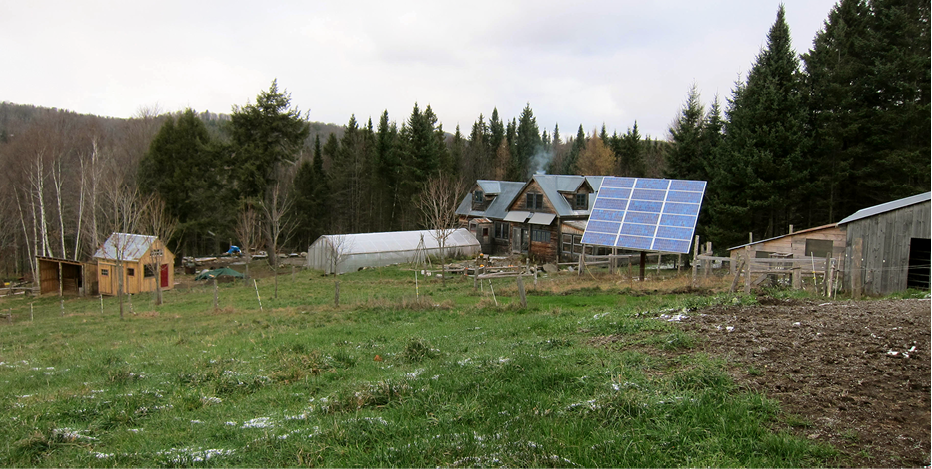
Same view, present day
As I mentioned in previous chapters, we are advocates of simple, inexpensive construction techniques for barns, outbuildings, and even human shelter. This is not because we wouldn’t want something grander, or that if money were no object, we wouldn’t choose materials and techniques that require less upkeep over the long haul. Would I like to lay my head under a slate roof that will last for hundreds of years? To be sure. Would I prefer to stack our cows’ hay in a post-and-beam barn of hand-hewn timbers? You bet, if only for the beauty of it. And maybe someday I will. But like most people I know, we live with limits of time, skills, and finance, and we have chosen to apply what resources we do have to the restoration of our land and the cultivation and gathering of our food.
Furthermore, I have observed that even the art of homesteading and small-scale farming can become a game of “wants” rather than “needs.” As much as many of us might desire to escape the bounds of the first-world consumer culture, we have all been socialized to certain assumptions and expectations. I often remind myself that there are cultures on this earth that have lived and thrived as tent-dwelling nomads for centuries, living with the land in the most humble and respectful manner imaginable.
While our infrastructure is generally unassuming and inexpensive, it has worked wonderfully for us, providing adequate shelter for our animals and their feed (not to mention ourselves and our feed) and requiring minimal investments of time and money. Furthermore, while our buildings may not be “fancy” or of craftsmanlike appearance, they are not without their own simple, rustic charm.
Perhaps someday we will build the soaring barn of our dreams, but that day is still at least a few years in the future. For now, we are content to invest the bulk of our energies and resources into the land and make do with the simple-but-effective pole structures that have sheltered our animals through many a winter.
the humble pole barn: a cost–benefit analysis
Our primary barn, used for storage of hay, milking, and winter shelter for sheep and goats, is constructed of cedar poles that form both foundation and frame. We chose cedar because it is relatively rot-resistant, and also because we have stands of cedar growing on our property, but if you have access to hemlock or tamarack (aka larch), these would be equal if not better choices. Siding is 1-inch-thick rough boards over nailers, and the roof is inexpensive-but-durable galvanized metal. The entire structure, which measures 20 by 40 feet and was built in less than 10 days, cost a bit more than $2,000. A large chunk of that cost was for the roofing itself; I was unable to find an adequate quantity of used roofing, and so was compelled to buy new. We’ve since gotten better at sourcing used materials before we need them.
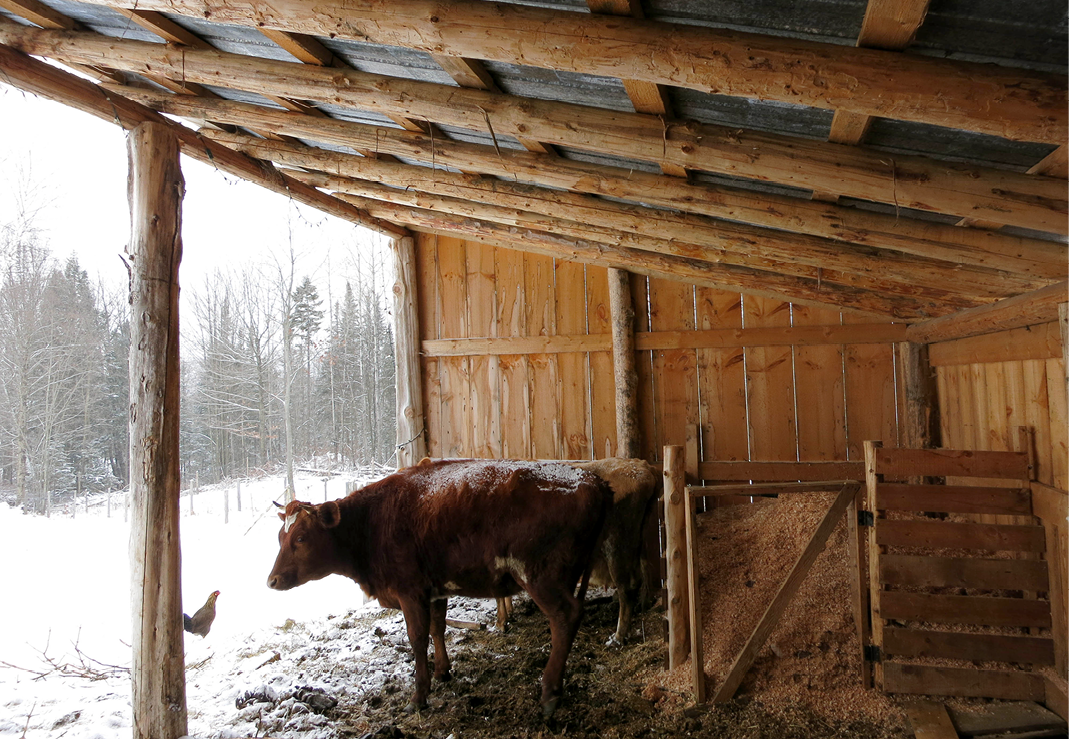
The cows’ winter loafing shed is an example of simple, inexpensive, and sturdy pole barn construction. This shed was built for less than $20 in fuel and nails.
Another significant portion of our barn expense was for siding boards; now we own a sawmill, and this cost would be mitigated.
Still, even with these expenses, a bit of rudimentary math tells me that we ended up with 800 square feet of usable space, at a cost of approximately $2.50 per square foot. The barn has been standing now for eight years and required zero upkeep; given the condition of the poles, I fully expect to get many more years of service out of it before potentially needing to replace one or more of the poles, a relatively simple task that can be completed in a matter of hours, including harvesting the pole.
Given this estimate, let’s conservatively assume 15 years of maintenance-free service at an initial cost of $2.50 per square foot. We therefore arrive at a bit less than 17 cents per square foot, per year. Of course, the barn is very likely to last a lot longer than 15 years with some further investment, which should only reduce the operating cost over time, but I think my point is made: There is simply no less expensive way to shelter animals and animal feed than under a simple pole barn.
Again, if we had either the necessary skills to build something grander, the time to learn those skills, no financial constraints, or less aversion to debt, our primary barn likely wouldn’t be of such humble nature. But I can see no way in which the relative simplicity and low-input nature of our barn has hampered our efforts in growing our food and restoring our land. In fact, because it was so inexpensive and quick to raise, it has only allowed us to invest more time, energy, and money into what really matters, which is the production of deep nutrition, the revitalization of our soils, and our connections to family, friends, animals, and community.
There’s another advantage to utilizing low-input infrastructure, which I hinted at earlier. It is difficult, if not impossible, to know with certainty how your homestead will evolve and what your needs will be in 5, 10, or more years. Already, having been on this land for less than two decades, I have seen how our needs have evolved and how our infrastructure must adapt to those needs. By having invested only modestly in our current infrastructure, we have freed up resources that can be applied to our evolving needs. Perhaps you are better able to forecast the evolution of your homestead—and if so, I applaud you. But my experience has shown me that the only certainty is change.
What, then, are its disadvantages? Life span, certainly, and the presumed need for repairs/maintenance to its foundation supports before a more permanent barn would need such intervention. Our pole barn will not last as long as a slate-roofed timber-frame structure set atop poured concrete frost walls. But then the energy embedded in the materials themselves is far enough less that I strongly suspect the pole barn wins on the embedded energy front, too. Weather-tightness is another disadvantage, although much of this could be remedied with only a bit of effort and expense on our part. Everything is covered and dry, but whatever is the ambient air temperature is the temperature we milk in, a truth that’s particularly hard to deny on 20-below January mornings. Our barn is not wired for electricity; if we need to tend to the animals during night hours, we must use headlamps. Obviously, there is no running water.

Fin reading while Penny milks
Still, for every morning I wish for a more enclosed milk room, there are 50 or more mornings the early sun slants its way through the open eastern wall and falls across my face. For every morning my fingers ache with cold, there are 50 or more mornings I’m grateful for the breeze that sweeps through the barn’s open end and for the opportunity to tuck my frosty nose into Apple’s warm flank. And in the eight years since we built the barn, we’ve carried literally thousands of gallons of milk through its entryway. We’ve kept thousands of bales of hay dry under its roof, and under that same roof, we’ve seen dozens of lambs, calves, and goat kids born. Not a single one of them has complained about being born into a pole barn.
Not only have they not complained, but the airflow provided by a partially open pole structure is actually healthier for animals than a more enclosed space. With the exception of sick or otherwise vulnerable livestock, animals are always better off with increased exposure to fresh air, sun, and even rain. As I’ve mentioned, we humans have a tendency to anthropomorphize the needs of our critters, assuming they are as frail and vulnerable as we are. In the rare event that we do need to shelter vulnerable stock, we simply create small holding pens within our pole structures that can be fitted with a heat lamp and other comforts.
I don’t mean to suggest that more substantial barns are inherently unhealthy; with proper design, any barn can offer ample exposure. I’m only pointing out that strictly from the standpoint of animal wellbeing, an inexpensive pole structure gives up nothing to a shelter costing literally tens of thousands of dollars more. In fact, the former may even hold an advantage.
good wood
I often joke that we are as dependent on wood for our health and wellbeing as we are on the food we grow. Except it’s not really a joke. We rely on wood to heat our home and our water, to provide shelter for our animals and ourselves, and to cook our food.
While it’s true that the local market could supply our need for high-quality firewood and building materials (something that’s not quite so true of food), it’s also true that wood products are a huge component of our homestead economy. Every year, between the cookstove and the heating stove, we burn approximately six cords of hardwood firewood; it would cost us at least $1,200 to purchase that firewood locally. And in just the past year, we constructed two outbuildings and a woodshed (see? We even rely on wood to shelter our wood!), as well as completing numerous other small projects from lumber harvested and sawn on our land. The total cost? Approximately $50 for fasteners and the fuel necessary to run our chain saw, sawmill, and tractor. True, this does not include depreciation of the equipment that enables us to process trees into firewood and lumber, but given that our appetite for forest products would otherwise cost us many thousands of dollars annually, I am very comfortable claiming that our tools have already paid for themselves many times over.
But the truth is, even if it cost us more to harvest our own firewood and sawlogs, we’d still do it, because the work is uniquely satisfying. There is nothing I love more than splitting firewood on a cold winter’s day, particularly once I’ve warmed to the task and my muscles feel strong and liquid. The work demands precision, strength, and suppleness, along with a certain grounding mindfulness that imbues me with a sense of knowing my place in this world and how to inhabit it. Often, Penny and I split together, side by side, each of us finding our own particular rhythm, chatting about the small matters of our life here. The boys split, too, though they’re prone to wandering off at random intervals.
Every Sunday morning throughout the winter, we work on firewood as a family. The boys tackle the rounds of easy-splitting ash and then, once our chopping blocks are nearly buried by the wedges of split wood, throwing them into the back of our old Ford truck for transport to the woodshed or porch, to be stacked for the coming season.
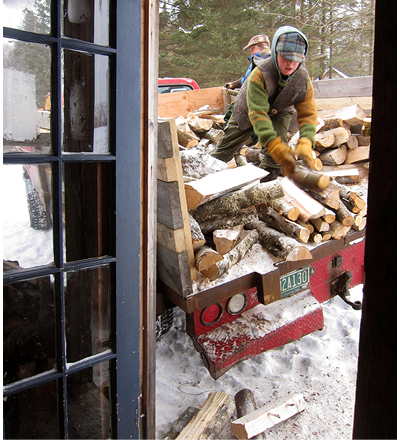
Some families go to church; we go to our firewood pile. Sometimes, I’m not sure there’s much difference.
finding a good woodstove: the hearthbeat of the home
In northern climates, the woodstove is the glowing heart of the homestead. For anyone with access to firewood, be it purchased or self-harvested, there is simply no appliance that is more valued or beloved. Wood heating is inexpensive, reliable, and, assuming access to a woodlot, entirely independent from supply chain vulnerabilities. Those who speak of wood smoke’s polluting influence are conveniently ignoring the polluting influence of other heat sources: the coal that must be mined and burned to generate electricity, the hydrofracking that dumps millions of barrels of chemicals into wilderness areas and into private water supplies in the quest for natural gas, the heating oil that is pumped and transported thousands—if not tens of thousands—of miles. The polluting influence of these fuels may not be as visible as smoke curling from the chimney, but it’s no less real for the people who live with it.
In my humble opinion, wood is also the finest heat source there is. Having been warmed by wood for nearly my entire life, I find central heating, be it of oil, gas, or electric origin, entirely unsatisfactory, almost as if I’ve developed partial immunity to it. I suspect this is not only because the heat source is hidden, but also because its distribution is too even. You cannot gather around an oil boiler or electric baseboards to warm your hands after evening chores. To sit before the open door of a wood cookstove firebox in the predawn hours, waiting for your coffee to perk while the stove iron ticks and creaks as it expands, is one of the small, sublime joys of winter, and not one that can be replicated by an electric range or propane heater.
Our home is heated exclusively by wood. As I’ve mentioned, we have two woodstoves; the main heating stove is centrally located in our living room and effortlessly heats our 2,000 not-terribly-well-insulted square feet to 70 degrees. The cookstove is naturally located in our kitchen (for summer cooking, we have a gas range on our porch and we are working on an outdoor wood-fired oven) and sees almost constant service from early October through mid-May.
Forty-plus years of heating with wood have taught me a thing or two about woodstoves, which can be summed up by the age-old acronym KISS (Keep It Simple, Stupid). The proliferation of catalytic converters and other secondary combustion systems on most modern woodstoves merely complicates and makes vulnerable an elegantly simple and reliable technology. What’s worse is that most of these systems feature baffles and other components that must be replaced at regular intervals, usually every three to five years.
What to look for, then? By far my favorite heating stove is the Vermont Elm, which was manufactured in Vermont (where else?) in the 1970s and ’80s and has since been resurrected by Vermont Iron Stove (see “Resources for Digging Deeper” for contact information). We’ve owned our 24-inch Elm (the stove is available in 18-, 24-, and 36-inch firebox lengths, depending on the square footage being heated: approximately 1,500, 2,500, and 3,500 square feet, respectively) for five years, and it is by far the best woodstove I’ve had the pleasure of standing beside on a cold winter’s day. First and foremost, the Elm boasts a round firebox with a circular opening. Those who do not split their own wood may not fully appreciate this detail, but those who do will likely realize that an unsplit round of wood is, well, round, and the similarly shaped door opening and firebox of our Elm readily accommodate the pieces of wood that thwart our splitting maul. It’s a rural truism that 10 percent of your firewood will require 80 percent of your splitting effort; with the Elm, we can skip a good portion of that 10 percent, knowing we can squeeze the full rounds into the stove. I also appreciate the long legs on our Elm, which make loading much easier than other stoves I’ve used. Even better, a 24-inch firebox is longer than most, and it means we can buck our firewood into longer rounds, which means fewer pieces of wood to split and handle. And while this is entirely subjective, I’d wager it’s the most beautiful stove ever made. Finally, my pragmatic nature is smitten with the fact that the door glass of the Elm is a standard pie plate, easily replaceable on the cheap in the event of breakage.
If you can’t find an Elm, I would look for an older Vermont Castings Vigilant or Defiant, depending on the size of your house. These stoves are far more common than the Elm, and it shouldn’t be terribly difficult to find one in good condition for a reasonable price (again, steer clear of the newer, catalytic designs). Five hundred dollars should net you a very nice stove. The Vigilant is generally good for up to 1,000 to 1,800 square feet; the Defiant will heat up to 3,000 square feet, assuming it’s fairly tight and well insulated. No doubt there are other brands and models worth considering, but these are the ones I have the most personal knowledge of.
Much as I love our Elm, we actually put more wood through our cookstove on an annual basis, simply because it serves multiple purposes. Obviously, we cook on it. We also heat water with it, via water jacket installed in the firebox and plumbed to our water tank, and also the old-fashioned way, utilizing big pots on the stovetop. Over the stove, we built a three-layer drying rack for herbs and vegetables. And rarely a day goes by when a few pairs of gloves and/or boots aren’t hanging near the firebox. Of course, our cookstove also provides heat; in the shoulder seasons of fall and spring, it throws enough warmth to serve as our primary heater.
I must admit that prior to taking the plunge and actually ripping out our gas range to make room for the wood burner, I was a cookstove skeptic. I was concerned that it would be inconvenient and difficult to cook on. I worried that we’d have to put up too much wood, and that it would take too long to make our meals. Frankly, it just seemed like a whole lot of bother.
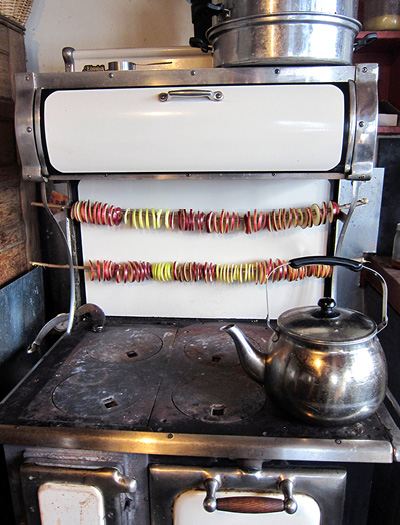
The Sweetheart and drying apples
That was then. Now, after a decade of cooking over wood at least eight months of every year, I’m a convert. I love our cookstove and consider a good cookstove to be an essential part of any homestead kitchen. Yes, we have to put up more wood. Yes, it sometimes takes a bit longer to cook a meal, particularly if we’re starting with a cold stove. But in addition to all the ancillary benefits—hot water, food and clothes drying, the simple pleasure of a small fire to warm the kitchen on a chilly autumn’s morning—cooking on the woodstove demands a level of participation and skill that adds richness to the experience. You don’t cook on a wood stove so much as dance with it, sliding pots and pans across the surface to find the ideal temperature, feeding the firebox with different woods to achieve the desired outcome. A nice fat piece of hard maple for a simmering venison stew; a few slender sticks of white birch to hurry along the morning’s first cup of coffee; a handful of dry ash to put the finish crust on a loaf of sourdough bread. Cooking on wood demands experience and knowing. You must know your stove, your pots, your ingredients, and your wood. Like so much of what happens on a homestead, there’s a satisfaction to this knowing that cannot be replicated by simply turning a knob to let the electricity or propane flow.
Unlike modern heating stoves, there is no regulatory mandate that cookstoves contain fragile combustion components, so even new cookstoves are not complicated by these technologies. Still, there’s little reason to buy new. Our cookstove is an Elmira Sweetheart we purchased used for $1,500; it had barely been fired and was essentially good as new for less than a third the original price. For whatever reason, wood cookstoves do not seem to hold much value, perhaps because not everyone finds cooking over wood as satisfying as we do.
I don’t have nearly as strong a preference for our Sweetheart as I do for our Elm heating stove, although I have no specific complaints. I will say that I do appreciate the relatively large volume of its firebox. Prior to owning the Sweetheart, we cooked on an antique Glenwood, and while it was a gorgeous stove, the firebox was so small as to be impractical. A small firebox necessitates very small firewood, which in turns means more splitting, and much as we love splitting wood, there are only so many hours in the day and plenty of other tasks demanding our attention. Even worse, the small firebox required constant tending; it felt as if we could hardly turn around without having to feed the stove. Finally, the firebox on our Glenwood was not large enough to accommodate a full-sized water jacket. We did install a stainless-steel water loop in the box, but the capacity was much less than our current stove.
I suggest that you find one with as large a firebox as possible. Our Sweetheart delivers in this regard, as does the Oval, which is a larger version of the Sweetheart (Heartland bought the designs from Elmira, so you might find them made under either brand). I can also recommend the Waterford Stanley based on reports from cookstove-owning friends. It’s another well-made, popular cookstove with excellent parts availability and . . . you guessed it, a fairly large firebox.
As much as we love both our woodstoves, if we could start from scratch (or if we came into a significant chunk of dough), we’d strongly consider installing a masonry heater. Masonry heaters are generally constructed of stone or brick and incorporate a firebox designed to burn at extremely high temperatures for short periods. The heat from these burns is captured in the mass of the heater—which can equate to multiple tons—and slowly released throughout the day. Well-constructed masonry heaters are elegant in both form and function. They are also extremely expensive; at one point, we toyed with the idea of hiring a mason to build us a heater, but once we started talking money, our humble woodstoves started looking a whole lot prettier. To have a masonry heater built by a professional is generally at least a $20,000 proposition, although many homeowners have designed and built their own for a fraction of that amount. For us, owing to the already-busy nature of spring, summer, and fall (the seasons during which a heater would have to be constructed), building one for ourselves simply isn’t an option, at least at this point in our lives.
tools of the trade: why you can’t afford the cheap stuff
Once upon a time, we had never heard the adage You can’t afford cheap tools, although even if we had heard it, we probably would have dismissed it out of hand. After all, we’ve never had a surplus of money, and we’ve always prided ourselves on our ability to get by.
I’m almost ashamed to admit how long it’s taken us to realize that we are not an exception to the rule. We truly can’t afford cheap tools. I’m also ashamed to admit how many broken tools we discarded along the way, how much frustration and stress we experienced, and—irony of ironies—how much money we needlessly spent replacing our failed “bargains”: the garden fork that shed three of its five tines over its first season of use, the consumer-grade chain saw that failed after only two seasons of operation and that would have cost more to rebuild than replace, the clunky splitting maul that’s approximately as effective as a bent butter knife. We got sucked into all of these deficient tools because the initial price was low. Well, that, and because we were ignorant.
We no longer buy cheap tools. This does not mean we don’t occasionally buy inexpensive tools; in fact, many of the high-quality tools we own and use daily were relatively inexpensive, simply because they were purchased used. For instance, I bought both of our chain saws used; each cost approximately half the price of new, and neither had had more than a few tanks of gas run through it. Our tractor and every implement we own was bought used; one of our favorite axes, a well-balanced, wood-handled beauty with a head of the sort of high-quality steel that can only be found on new axes costing $100 or more, was purchased for a mere $10. This list could go on for quite some time.
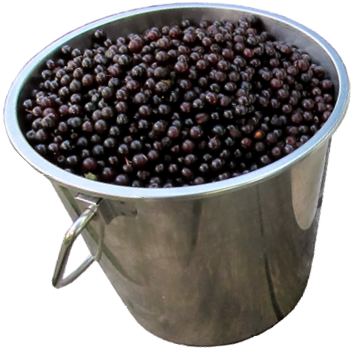
Unlike so many of the goods we use on a day-in, day-out basis, we view tools not as consumer items, but as a critical investment in our homestead. Because without these tools, we cannot do the work necessary to sustain this life.
We are increasingly applying this ethos to the majority of the items we rely on, as well as moving in the direction of surrounding ourselves with simple products crafted from natural materials. The boys now eat the majority of their meals out of bowls fashioned from spruce burls, slurping their soup from spoons Penny carved them. The majority of our synthetic clothing, having been worn to shreds, has been replaced by natural fibers, either those we’ve made or those we’ve purchased.
As with so many other aspects of our life on this homestead, we believe that the items we come into contact with on a regular basis are a reflection of the world we wish to inhabit, and the world we wish to inhabit is one where quality, durability, and simplicity matter. And where landfills aren’t overflowing with our broken crap.
Chain Saw: The Best Use of Gas Ever Invented
In the hierarchy of homestead tools, the chain saw is the undisputed champion. I honestly can’t think of a more elegant and efficient use of combustion technology anywhere. The return on fossil fuel investment you get from a chain saw is phenomenal; for a few gallons of gas and oil, I can keep my family warm for an entire winter. Okay, so there’s a good bit of labor involved, too, but the chain saw exponentially reduces the physical work necessary to transform standing wood (aka “trees”) into fuel. I’d give up our car, truck, and tractor long before I’d give up our chain saw. If there are fossil fuel shortages in my lifetime, I know exactly where my last gallon of gas is going.
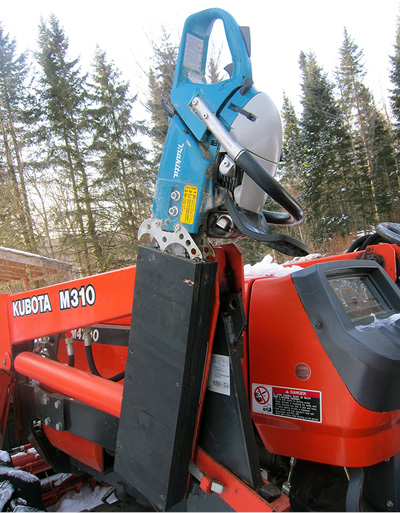
A simple chain-saw carrier made out of scrap plywood and bolted to a tractor loader frame
Gas chain saws are capable of a heck of a lot more than firewood, too. We’ve constructed more than one shelter using a chain saw as our primary cutting implement. And although we have a dedicated band saw mill for sawing lumber (see below), a relatively inexpensive chain-saw mill is a huge contributor to homestead resourcefulness.
Of course, there is a caveat to chain saws, and it is this: They are probably the most dangerous homestead tool you’ll ever lay a hand on. They’re more dangerous than a table saw, more dangerous than a circular saw, and far more dangerous than a gun. Sure, all of these things can hurt you or worse, but assuming all are handled properly, none are as potentially harmful as a chain saw, in large part because the dangers inherent to operating a chain saw require a higher degree of operating skill to manage. If that’s not convincing enough, know that the average chain-saw injury requires 110 stitches to close and carries a price tag north of $10,000. And that’s just the risk posed by the saw itself. In fact, the most deadly aspect of working with a chain saw is the wood you’re cutting. Live trees harbor enormous energy and force, and no one should venture into the forest with saw in hand without knowing how to “read” a tree’s stored energy.
I don’t mean to scare you away from the best darn homestead tool money can buy. I only mean to scare you into a certification course that could very well save your life. Like almost every chain-saw user I know, I used saws extensively for the majority of my adult life without formal instruction, skating by on good luck and a modicum of common sense. But in 2013, I completed an instruction course known as the Game of Logging (GOL), and it transformed my relationship to my saw and to the wood I cut. It also demonstrated to me just how profoundly I’d been relying on luck and how likely it was that my luck would eventually run out.
The beauty of the GOL is that it applies a replicable, step-by-step process to practically every woodland scenario you’re likely to come across. As such, even rank beginners can fell trees with tremendous accuracy and safety. While it is far beyond the scope of this book to offer specific chain-saw instruction, it is well within the scope of this book to say that you should consider Game of Logging instruction to be as mandatory to your use of a chain saw as the saw itself.
So, what of the saw itself? Passionate loyalties to brand and size run high, so be prepared for conflicting advice. My experience compels me to say that if you are going to own one saw (we own two), I strongly recommend a professional-grade machine in the 50cc range from one of the following manufacturers: Dolmar/Makita, Husqvarna, Jonsered (which is owned by Husky, and is therefore simply a Husky painted red), and Stihl. I say “professional-grade” because pro-grade saws are rated for thousands of hours of use between rebuilds, while consumer-grade saws like those found at big-box stores might be good for only a couple hundred hours of cutting at best and are hardly worth rebuilding. I say “50cc” because unless you live in the midst of old-growth redwood forest, or are cutting nothing but 2-foot-diameter white oak, or are searching for a saw to run a mill, a good 50cc saw will do everything you need. Perhaps more crucially, a 50cc saw is significantly lighter than the 70cc and larger saws commonly used by professional loggers. The two most dangerous factors when it comes to operating a chain saw are (1) fatigue and (2) fatigue. (For the record, the third and fourth most dangerous factors are also fatigue and fatigue. What’s the fifth? A dull chain.)
The 2- or 3-pound difference between a 50cc saw and its 70cc sibling may not seem like much if you’ve only got a cord or two worth of logs to buck (the term for cutting firewood into manageable lengths) into stove-length rounds, but after a few hours in the woods, you’ll be astounded at the difference. Yes, a smaller saw cuts slightly slower, but because you’ll be less tired operating it, you’ll actually get more work done and get it done more safely.
If you want a specific saw recommendation, I believe you can do no better than a Husqvarna 346 XP. In fact, the 346, which is a 50cc saw, is so well regarded that many professional loggers use them extensively for ground work. The only downside is that Husqvarna no longer makes the 346; like many popular saws, it has been discontinued due to increasingly strict pollution control mandates. This might sound like a good thing, until you realize that most of these mandates actually decrease the life span of two-stroke chain-saw engines, necessitating more frequent rebuilds or replacements. For this reason, I highly recommend searching for a good used 346 (the “buy used” suggestion applies to all saws, not just my beloved 346), rather than buying the latest and not-so-greatest.
If you feel the need for a bigger saw, look for a Husky 372 (by the way, don’t ever walk into a saw shop asking for a “Husqvarna”; the term Husky is used so ubiquitously they might not even know what you mean) or Stihl 440 (steel, not stile). Both are rock-solid saws in the 70cc range. Our larger gas saw is a Makita (made by Dolmar) 6400, which I also unreservedly recommend. It’s 64cc, built like a brick shithouse, and cuts like mad. But at 14 pounds, it’s a full 3 pounds heavier than our 346, and at least 80 percent of the time, I find myself reaching for the Husky, reserving the Makita for only the largest cutting jobs. Penny never, ever uses the Makita; it’s simply too cumbersome for her 130 pounds.
Please do not allow yourself to become wrapped up in the bar-length arms race. In my experience, even on a larger saw there is little reason to install anything longer than an 18-inch bar, and in most cases, a 16-inch bar is more productive. This is something that was confirmed to me at the GOL course, where my instructor convincingly demonstrated the vast difference in nimbleness (and therefore speed and safety) between a 16-inch and a 20-inch bar, never mind the 24-inch bars on many larger saws.
Longer bars are heavier, more dangerous (simply because there’s that much more bar to bite you), less maneuverable, and require more expensive chains, which take longer to maintain, because of the additional teeth. With a 16-inch bar and proper technique, you can easily drop a 30-inch-diameter tree, and while a 70cc saw is certainly capable of pulling a 24-inch bar, it’ll cut even faster with something shorter. I have found that in the vast majority of situations I’m likely to face in the Northeast, and assuming proper technique, a bar longer than 18 inches is a liability, not a benefit.
Finally, it’s absolutely critical to maintain a sharp chain. For most serious woodsfolk, this means learning to sharpen their own chains, although some people choose to have their chains professionally sharpened. Personally, I’m not willing to deal with the hassle or expense of taking my chains somewhere to be sharpened, so I’ve learned to put a pretty good edge on them at home. Some of the best advice I’ve gotten is to take a few sharp chains with me to the woods, swapping them out as they become dull. Then I can sharpen them all in the comfort of my basement or even on the kitchen table with a cold beer and a radio tuned to classic rock close at hand. Again, it’s beyond the scope of this book to provide sharpening instruction, but if you take my advice and sign up for a GOL course, you’ll get it there.
The Splitting Maul: And Why We Split Our Firewood by Hand
Nearly a decade ago, we borrowed a neighbor’s gas-powered hydraulic wood splitter to help put up our annual firewood supply. I was about halfway through the pile when I came across a few rounds of beech that were about 2 feet in diameter. Beech is not light; 18-inch-long, 2-foot-diameter rounds of green beech are really not light, but I figured I was a tough young thing, so I bent over and commenced to tug and grunt in the hope of getting it onto the splitter. On about the third grunt, I felt an alarming shift in my lower back, followed by searing pain. I spent the next week in bed, literally crawling to the bathroom. We have not used a gas-hydraulic splitter since.
Truth is, I can’t really blame the splitter for my injury; our decision to revert to hand splitting had more to do with the fact that hand splitting allows us to opt out of the noise and expense of machinery. Besides, we like splitting wood with a maul. It just feels good, and since we do most of our splitting during the winter months, it helps keep us strong and flexible during the time of year when our physical activity is at a natural, seasonal lull. Splitting by hand certainly isn’t as fast as splitting with hydraulics, but with the right wood, the right maul, and good technique, it’s not all that much slower. Perhaps best of all, the absence of a combustion splitter allows us to banter and chat while we split. And I wonder if Fin and Rye would feel so capable and useful if they didn’t have the experience of swinging a maul by hand. By the way, you don’t “chop” firewood; you split it. Chopping is the act of cutting across the grain, such as when felling a tree.
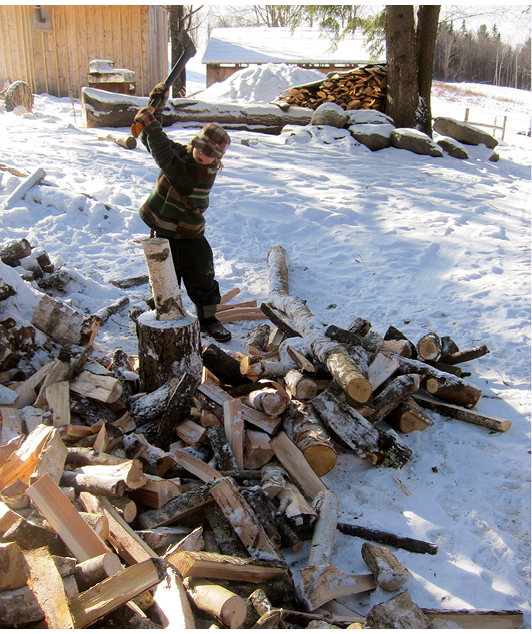
There are a lot of junky splitting mauls on the market. The absolute worst thing you can do is buy the cheapest model your local hardware or building supply store offers. The vast majority of those mauls are either too heavy, improperly shaped, poorly balanced, or (in most cases) all three.
I can wholeheartedly endorse any splitting tool made by Fiskars and its sister company Gerber. Being tall, I’m particularly fond of the Fiskars X27 Super Splitting Axe (never mind that axes are historically considered chopping implements for cutting across the grain, rather than splitting along it—this is definitely a splitting tool!), which has a 36-inch handle for tremendous leverage. Shorter users will do better with the X25 Splitting Axe. If money is not an issue, I recommend the Gränsfors Bruk Splitting Maul. It’s a piece of functional art. It’s also nearly $200, which is why it’s a piece of functional art that we do not own, at least not right now. It’s not that we wouldn’t pay $200 for such a tool—indeed, it’s precisely the sort of thing we’d splurge on—but at this point in our lives, with so many hands to keep busy, we’re better off owning multiples of a more affordable maul. And because the Fiskars mauls feature composite handles that won’t suffer from weather exposure, we simply leave them propped up at the woodpile so that anyone passing by can take a few whacks.
The Sawmill: From Tree to 2-by-4
Three years ago, we inherited a sawmill from the wife of a dear friend who passed away. Prior to being gifted his mill, we had occasionally considered purchasing one for ourselves but had always chickened out at the last minute; a sawmill is not an inconsequential investment, and it never rose quite high enough on our list of priorities. But having now seen what is possible with a smallmill, I can hardly believe we purchased all the lumber we purchased over those years we did not own one. I highly recommend it for anyone who owns a healthy woodlot of at least 10 acres or more.
There are numerous different types of sawmills on the market. My experience is limited to the sort of semi-portable band sawmill that we own. This is the most common style of mill for home and farm use, although occasionally you’ll see a larger circular sawmill that someone’s rigged up. The portable chain-saw mills (aka Alaskan mills) are a fairly popular and relatively inexpensive option, although I must reiterate that I do not have personal experience with one of these rigs.
A good band saw mill like ours is not cheap; even a used one will set you back at least a few thousand dollars, and they can quickly run to five figures if they’re outfitted with conveniences like hydraulic log loaders. Ours is a pretty simple affair, requiring a good bit of manual log handling, but it is still an amazingly productive piece of machinery. Although it depends on a number of factors such as log diameter, length, and general condition, I can generally mill a couple hundred board feet per hour, once I have the logs at the landing. This equates to about $100 worth of rough lumber every hour (assuming the local going rate of 50 cents per board foot for rough-cut lumber), not including the time it takes to harvest the logs. If I account for that, it’s probably more in the neighborhood of $50 worth of lumber per hour, although it’s worth noting that I don’t have to drive anywhere to pick up the lumber milled on our property.
The industry-standard home band saw mill brand is Wood-Mizer (our mill is essentially a Wood-Mizer knockoff, made by a small Canadian company called SMG Champion), although there are numerous other good mills on the market. What’s more critical than the actual brand are the capacities of whatever mill you’re considering and how those relate to the logs you want to saw. Some of the smaller mills cannot handle logs much above 20 inches in diameter, and some come with tracks that are only 12 feet long, which means you can’t make lumber longer than that (although most can be added onto). Our mill can handle 30-inch-diameter logs and has 17 feet of track, and this has proven more than adequate for anything we’ve sawn yet. In fact, handling logs any larger than this is a real challenge and potentially hazardous, as they can weigh thousands of pounds.

Tractor with Loader: A Love–Hate Relationship
We have a love–hate relationship with our tractor, which, in my opinion, is second only to the chain saw in its ability to extract value from a given quantity of fossil fuels. Of course, this very quality makes tractors ripe for abuse. Tractors are seductively powerful and can quickly drive a wedge between the operator and the land. We have learned to work slowly with our tractor, remaining mindful of our actions.
But while I have enormous respect for those who chose to avoid tractors for homestead operations, and while we have long fantasized about training a team of oxen to help with traction-related tasks, I am grateful for our tractor, which allows us to accomplish much more than we could with physical labor alone and performs tasks that are beyond the reach of oxen or horses. In a matter of seconds, burning at most a couple hundredths of a gallon of diesel fuel, I can lift and move literally a ton of manure. Over the course of two long afternoons, I can drag enough log-length firewood from our woodlot to heat our home for the entire winter.
For us, the key to maintaining a healthy relationship with this incredibly capable machine is to use it in full awareness and appreciation of its power. We are always seeking ways to reduce our dependence on our tractor, for reasons of resourcefulness (after all, a tractor is highly dependent on vulnerable energy supply chains), our relationship to the land, and simple economics: Diesel fuel, maintenance, and repairs don’t grow on trees. I believe that the more we use our tractor, the more our relationship to the natural world is compromised, and for us, it is of utmost importance to bear this in mind, even as we exploit the tractor’s potential to improve the overall quality of our lives on this piece of ground. The truth is, there is simply no way we could do all the things we do without this machine, and for us, the practicality of thoughtful tractor use prevails over solely human or animal power.
Owing to the scale of our homestead and our beliefs around soil management, we do exactly zero cultivation with our tractor. Instead, we utilize it for what it does best: lifting and pulling. The lifting is most often in the form of manure and bedding management, along with feeding logs onto the sawmill. Our pulling tasks are most frequently forestry-related, skidding firewood and sawlogs from the woods. More often than I care to admit, the tractor is also pressed into service to extract our plow truck from where I’ve mired it in a bank of snow.
Because we don’t do a lot of heavy soil work or haying with our tractor, we can get by with a somewhat smaller machine than we’d otherwise need. It’s difficult to recommend a specific size tractor, since size and horsepower should be dictated by the jobs at hand. Still, I can say that even a compact four-wheel-drive tractor in the 20- to 30-horsepower range and equipped with a front loader (aka bucket) is capable of stunning amounts of work. Our machine is a 50-horsepower Kubota, built on a “utility” chassis, which means that it is heavier and more stable than the popular compact tractors in the 30- to 40-horsepower range. This is particularly important to us because our land is so hilly, and one of the quickest and potentially least pleasant ways to die on a small farm is to roll a tractor and be crushed underneath. If you are shopping for used tractors, be sure the one you buy either is equipped with a roll bar or can be.
Interestingly, larger utility-sized tractors are often less expensive than smaller models, probably because there’s a larger and generally more affluent market for compact machines.
Finally, I’m not a big fan of cabbed tractors for basic homestead use. Cabs increase the cost of the machine significantly, complicate repairs (since they must be removed to perform many common repairs, such as clutch replacement), and are prone to abuse in the woods. Being enclosed in a cab creates even more distance between oneself and the environment, as well as impairing visibility in tight quarters.
Guns: An Essential Tool with Lots of Baggage
Gun ownership is a touchy subject for some, as it once was for us. Both Penny and I were raised in gun-free families, with a general sense that guns were dangerous and perhaps even inherently bad. But we have come to understand that there’s simply no excuse for not having a ready way to painlessly euthanize an animal suffering from disease or injury. It is our belief that if we are going to accept the responsibility of caring for animals, we should also accept the responsibility of potentially having to put them down. Of course if you’re planning to do your own slaughtering, as we do, you’ll certainly need a gun for that.
The challenge for those of us not raised in gun-savvy families is that determining what gun to buy is a steep and daunting learning curve. The sheer number of calibers (the general stopping power of a gun is determined by the caliber of the ammo it fires) is compounded by an overwhelming diversity of personal preference and opinion. Ask six different gun owners what they’d recommend, and you’re likely to get six different answers, which explains in part why it took us a couple of years to finally settle on the right homestead firearm. Truth is, we haven’t settled on just one firearm; after borrowing, buying, and selling a handful of guns, we have acquired a small collection of firearms in varying calibers, for varying purposes. Fortunately, firearms hold their value extremely well, so it’s relatively inexpensive to trade.
There is no “perfect” homestead firearm, because different situations call for different guns. That said, the one firearm we use most often is a .22 rifle. A well-placed .22 bullet is capable of instant kill on most common homestead species (if you’re keeping, say, water buffalo, you might consider something larger, and I should point out that we use a .410 shotgun for particularly large hogs and beef animals, because the skulls can become too thick for penetration by a .22 and because there’s a greater margin of error if the shot isn’t ideally placed). Furthermore, a .22 is a very manageable caliber for neophyte shooters; recoil is essentially non-existent, and it’s much quieter than larger firearms. Finally, used or even new .22 rifles are extremely affordable; there’s little reason to spend more than $200, and it’s entirely possible to find an excellent specimen for half that. You don’t need anything fancy. Even the cheapest guns are extremely reliable and accurate.
The only real downside to a .22 is that because it is a relatively low-power caliber, it does require a well-placed shot directly to the brain, preferably from no more than a few feet away. This is problematic if you need to bring down a marauding hog or beef cow or if you want to use your gun for hunting (this is why we also own a 20-gauge shotgun, as well as a .308 deer rifle). Still, such a situation is probably beyond the comfort zone of an inexperienced shooter, and you might be better off seeking assistance, anyway. Another potential solution to the need for multiple caliber guns is to buy a model that features interchangeable barrels; the first gun we bought was a single-shot youth rifle that came with both .22 and .410 shotgun barrels. This is a great combination for the homestead, as long as large-game hunting isn’t in the cards.
It probably goes without saying—but it’s important enough that I’m going to say it anyway: You should never, ever use a firearm without proper training. The perceived risk posed by firearms is much, much higher than the actual risk; your chances of being injured or killed in a car accident far exceed your chances of suffering a gun-related injury, and when used with proper technique, a gun is one of the safest, most predictable tools you can own. If you have children and they’ve demonstrated appropriate maturity, I’d highly recommend taking a hunter safety class as a family. These are available through your state fish and wildlife agency. Family hunter safety classes offer the dual benefit of providing everyone in the family with the experience they need to shoot and handle a gun safely and removing some of the taboo associated with firearms.
skills: the gateway to true freedom
Recently, we heard a news segment on the radio discussing the need for children to begin learning computer programming at an early age. Apparently, the magic window of opportunity when a child’s mind is developed enough to assimilate the information—but not so developed that the knowledge does not imprint itself in some deep and irreversible way—is the age of five. I can’t help but wonder how different the world might be if teaching five-year-olds how to cook and mend clothing were as important to us as teaching them how to write code.
Of course, it wasn’t long ago that learning such skills was an important part of almost every child’s education. Today, thanks partly to budget cuts and partly to a collective societal agreement that skills of the hand are no longer worthy of our children’s attention, we’ve abandoned this learning to make room for more practical knowledge, with practical being defined in terms of career preparedness. How tragically ironic that the truly practical life skills essential to providing for self and community have been usurped by the pragmatism of employability.
I am always bemused and somewhat saddened to hear our political leaders calling for more “skilled” workers, because I know that the skills they speak of are the specialized skills demanded by industry. They are the skills that are most profitable to the companies that make up industry, not those that liberate us to provide for ourselves and serve our communities outside the context of the moneyed economy. By training our children and ourselves to do the bidding of industry, we are in essence commoditizing them. Our collective lack of personal capability—to build our own shelters, tend our own gardens, process our own animals, maintain our own tools, and so on—ensures that we are never truly free.
Not for a second am I suggesting that everyone reading this book must come to embody every skill necessary to turn their back on the consumer economy. My family certainly doesn’t. Instead, we have chosen to focus on acquiring those skills that (1) enable and support our homestead; (2) are not readily available in our immediate community; (3) save us the most money and/or time and hassle; (4) we can do better than others; and (5) enrich our lives in other ways. In other words, for the most part, we focus on those skills we deem most pragmatic.
It is beyond the scope of this book to provide detailed instructions in every possible homestead skill. To do so would mean you’d need a team of oxen just to haul the thing around, and when it came time to read, you’d have to climb atop their backs so you could turn the pages. And rarely is a book the best medium for learning specific hands-on skills; for that, you’re always going to be better off finding someone who can work with and even mentor you, who can demonstrate how much of a difference just a small adjustment in blade angle or hand position can make.
The age of YouTube has been both a boon and a curse to skills learning. It’s a boon because of course anyone with an Internet connection now has access to literally millions of searchable skills videos, and some of them are quite good. It’s a curse because these videos threaten to further erode the face-to-face transfer of these skills and the already-faltering mentor–apprentice culture. Real-life skills have disappeared from our communities in large part because of the emergence of technology and industry, and it seems specious to suggest that these same forces will somehow bring them back. Yes, you can learn specific skills on the Internet, but a bunch of people reskilling themselves in front of computer monitors will not restore the cultures in which these skills flourish and are passed down, nor will they support the few remaining skilled workers in their communities. YouTube cannot help us experience the joy and necessity of real human connectivity, which is quickly being lost to the artifice of Internet connectivity. While I can’t claim that we never turn to the Internet for skills-based learning, I can say that we almost always try to seek out face-to-face instruction first. Yes, sometimes it costs more. But the “free” instruction that comes over our computers also comes at a price, and part of that price is the increasing irrelevance of the remaining elders in our communities who still embody this knowledge.
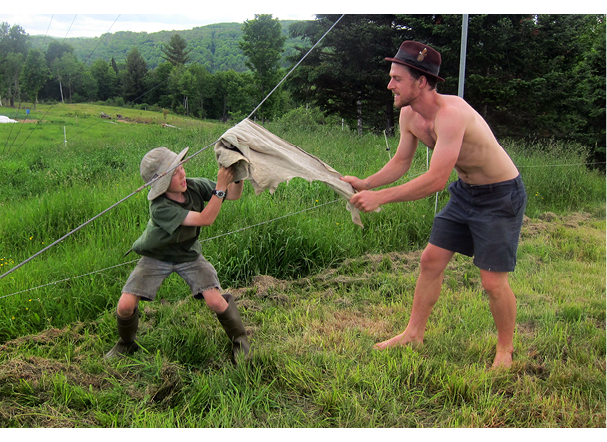
Rye and our friend and mentor Erik working a deer hide over a windmill cable
While many of the skills essential to a thriving homestead are those of the hands, we are often struck by how many are those of the head. In other words, they are interior skills of perception and understanding borne of experience. These skills cannot be taught; they can only be learned. But I include them anyway, if only because we often wish we had started learning them earlier than we did.
In the preceding chapters, I’ve already touched on many essential homestead skills, such as food preservation, animal management, and basic butchery. The following are other skills we employ on a regular basis.
Basic Building Skills
I almost wrote “carpentry,” but the truth is, you needn’t be a carpenter to keep your homestead humming along. The homestead does not require craftsmanship, but it does demand a basic grasp of building techniques, along with enough tool-operating experience to mitigate the threat of injury. Sometimes it seems as if we can’t get through a day without picking up a hammer and saw, and I cannot overstate just how crucial it is that any would-be homesteaders familiarize themselves with basic building methodology.
knife/saw/ax sharpening
As the old saying goes: If you have 20 minutes to cut, spend 15 minutes sharpening. A dull knife blade or chain-saw chain is probably the most dangerous device on a homestead. It’s also the most inexpensively and quickly remedied, although it’s shocking how many people fail to maintain well-honed cutting tools, probably because they just don’t know how. After years of practice, we are still perfecting our sharpening techniques, but even an imperfectly sharp cutting implement is better than a perfectly dull one.
plumbing
Considering that most licensed plumbers charge upward of $75 an hour, learning basic plumbing skills is well worth your time. Better yet, the necessary tools are extremely affordable. The hardest part of plumbing is sweating joints, but with a little practice, it’s something anyone can do. Even us.
wiring
Wiring is much like plumbing: expensive to have done, relatively simple to do yourself (though for complicated jobs, we have hired professionals). Just be sure the breaker switch is off, okay?
sewing
You needn’t actually be able to make your own clothing (though it’s really inspiring if you can), but you’d better be capable of patching the knees of your favorite work jeans. Truthfully, this is one I’m still struggling with; it takes me hours to patch a hole that Penny or even one of the boys can do in 15 minutes or less, and every time I sit down with a needle and thread, I need a refresher on how the two go together. But I’ll get there.
We’ve also found it invaluable to have basic leather stitching equipment, primarily for making knife and ax sheaths.
mechanics
For those of us who are not mechanically inclined, I cannot overstate just how crucial a good mechanic is to this life. A good mechanic is central to a prosperous rural life, because there’s no way you can live the life we do and pay dealer prices to repair your car. You need a mechanic who can keep a rig on the road long past the point any dealer would’ve tried to flip you into a new model, complete with 0 percent financing and low, low monthly payments. You need a mechanic who’ll lean over the engine compartment with you and listen while you describe your own fumbling attempts to fix the damn thing yourself and why you believe that somehow imbues you with insight regarding what the problem actually is. You need a mechanic who’ll patch up the mess you made and then address the real issue, using parts pulled off one of the junkers sinking into the weeds on the fringes of his lot.
But you also need to be willing to get your hands dirty, because much of the machinery—be it motorized or not—that enables this life is not readily transported to a mechanic. We are not expert or even intermediate-level mechanics, but we have committed ourselves to learning basic maintenance for the machines we rely on. At the very least, keeping this machinery maintained will reduce the frequency of breakdowns and extend its life span.

metalworking (welding, blacksmithing)
Our metalworking skills are almost nil, a reflection of the fact that we live in a community of many skilled welders and blacksmiths. This proximity, coupled with the learning curve and initial equipment investment, has kept these skills on the back burner. However, if we didn’t have such ready access to skilled metalworkers, we’d certainly learn basic welding. Metal repairs are a frequent occurrence on any working farm or homestead. Fortunately, this is a skill our boys are particularly keen on learning, so my guess is that we’ll be diving into it sooner rather than later.
drop spindling
Spun fiber is an essential component of human survival but is something we all take for granted. Socks, sweaters, hats, shirts, dish towels, and blankets are part of everyone’s daily life, though few of us have even the faintest idea how to make these items for ourselves.
The drop spindle is a ridiculously simple, productive, and versatile device. With enough practice, it can actually be faster than a spinning wheel—and even a dexterous five-year-old can use it to make fiber. Best of all, spindles are easily made from a branch or dowel and round of wood. Once complete, they’re entirely portable; you can carry a drop spindle and batch of wool with you just about anywhere.

Making fiber
knitting
Even if you’re not spinning your own fiber, knitting is a practical and satisfying skill. There is nothing quite like donning a warm sweater or hat on a winter’s day, made by your hands or those of someone you love. It’s also one of the most portable skills. We have all learned how to knit, though I won’t be churning out any complicated patterns anytime soon. I’m not going to get specific regarding all the different options for knitting supplies; my best advice is to find a friend or family member who knits (everybody has one!) and let them help you get started, since this is a skill that particularly lends itself to sitting next to someone experienced while you learn.
foraging
The longer we live on this land, the more we rely on the wild and semi-wild uncultivated fields and forests for our nourishment. Foraging is an incredibly empowering skill; perhaps more than anything else, it has altered our view of the natural world, and helped us understand just how generous and abundant nature is. It’s rare for us to go on a woods walk in spring, summer, or fall without filling our pockets with mushrooms, wild onions, fiddlehead ferns, chaga, wood sorrel, nettles, and so on. The boys might return home with a length of hardhack for a bow, and Penny a spruce burl to be carved into a bowl.
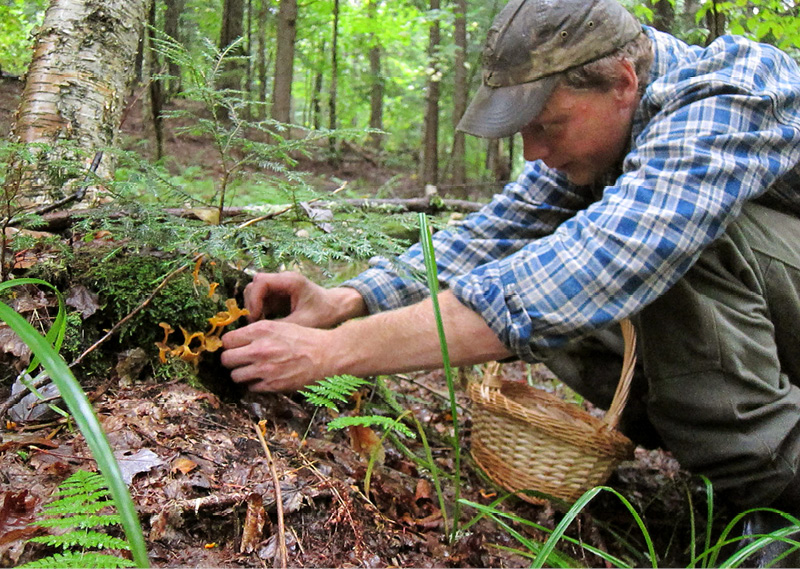
Foraged chanterelles have become a staple in our winter soups and stews.
With the exception of our frequent mushroom and wild blackberry gathering, most of our foraging happens in the course of other activities. Often, it occurs in the most unexpected places: In three of the past four winters, we’ve filled our freezers with venison, courtesy of roadkill deer (and because these were all hit by other drivers, we didn’t even have to fix our car).
While the perceived danger of illness or death by poisonous wild plants and fungi is far greater than the actual danger, it’s obviously crucial to learn which species of flora are potentially harmful. We are fortunate to count many expert wildcrafters among our friends and have benefited tremendously from their experience and willingness to share it. Guidebooks are essential also, although we consider our guidebooks to be secondary to the knowledge of local experts, and we use them for confirmation only. Our friend Erik, one of our primary foraging mentors, goes by the rule One human and two books.
The “Other” Skills
I’ve segregated the following skills not because we don’t think they’re important, but because to us, they’re important for a different reason. These are not skills we depend on day in, day out (or even week in, week out), nor do they save us a meaningful amount of money, and in this regard, I suppose these are not the most logical or practical skills for us to pursue. But as you’ve probably already determined, our view of what is logical and practical extends to that which enriches our life in ways that defy easy explanation. Besides which, it’s nice to know we could do these things if we ever really needed to, and the pleasure derived from being able to produce something as essential as a pair of shoes or spoon to eat from is no small thing. In the case of skills relating to animals, it is one more way we can honor and connect with these creatures by utilizing every part we can.

Buckskin shoes with moose antler buttons
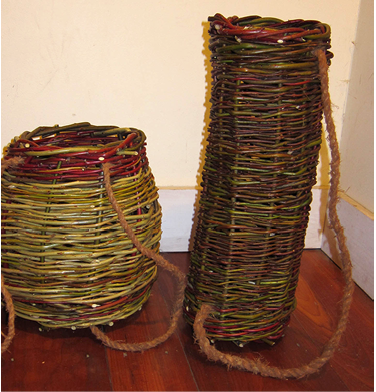
Willow baskets with cedar bark straps
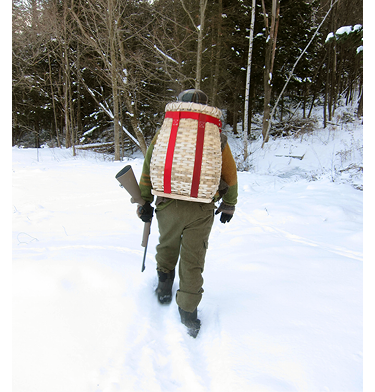
First hunt with a new black ash pack basket

Rye and our friend and mentor Nate smoking beaver hides
processing hides
Penny and the boys have made rawhide from beef hides and buckskin from the roadkill deer we’ve gleaned. Fin and Rye have also made bedrolls from sheepskins and tanned pelts from all the animals they’ve hunted or trapped, including weasel, squirrel, chipmunk, skunk, muskrat, beaver, and rabbit. From these hides, Penny has made moccasins and the boys have made huaraches (basic, rugged sandals favored by natives of the southwestern United States), knife sheaths, other simple pouches, and hats.
basket making
Our collection of wildcrafted baskets includes numerous containers made of birch bark and basket willow, in addition to the boys’ black ash pack baskets, woven from ash splits they pounded. Again, it is primarily Penny and the boys who’ve cultivated this skill and who will soon coach me through my first pack basket.
felting
Of all these skills, felting is perhaps the one that sees most frequent use. Needle felting is a great method for patching holes in wool pants and sweaters. We (and by “we,” I mean Penny and the boys yet again) have also felted vests, hats, puppets, balls and other toys, and various pouches.
carving: spoons, ax handles, bowls, knife handles, and more
At times, our living room floor is nearly obscured by curls of wood shavings as the boys work on their latest creation. Our friend Erik loves sweeping our living room, simply because it’s so satisfying. “It’s almost like raking,” he says.

A felted wool cap
Carving simple wooden utensils is a great introduction to woodworking skills; pretty much anyone (even me!) can make a beautiful and functional spoon in one or maybe two evenings, and it doesn’t take much more time to craft a sturdy ax handle or turn a spruce burl into a soup bowl. As master carver Alexander Yerks is fond of saying, “We all like to eat, and metal or plastic sort of sets up a dull mood before you even take your first bite.”
hunting and trapping
Before the boys expressed their strong interest in hunting and trapping, neither Penny nor I considered acquiring these skills. We had not been raised in hunting families, and given the abundance of animal products we produce on our homestead (along with our frequent roadkill scores), sourcing wild meat seemed unnecessary.
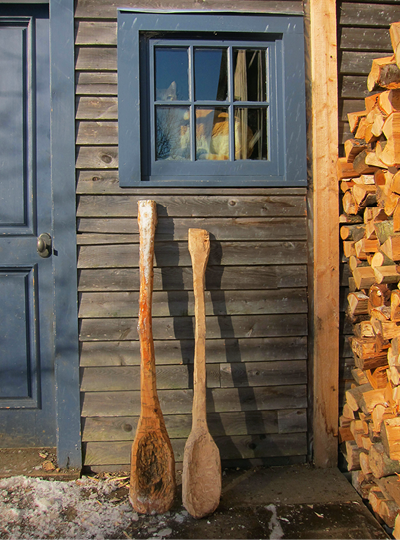
Cree snow shovels in progress
The boys remain the primary hunters and trappers in this family, filling our Crock-Pot with squirrel, rabbit, beaver, muskrat, and most recently crow. These are not necessarily Penny’s and my absolute most favorite meats, but the boys always grease their chins with gusto. Furthermore, their rodent potpies and woodchuck chili are always a big hit at our seasonal gatherings. And truth be told, even Penny and I have developed a taste for beaver liver pâté, which is milder than the pâté we make from our domesticated livestock.

Woodchuck being transformed from garden pest into potpie